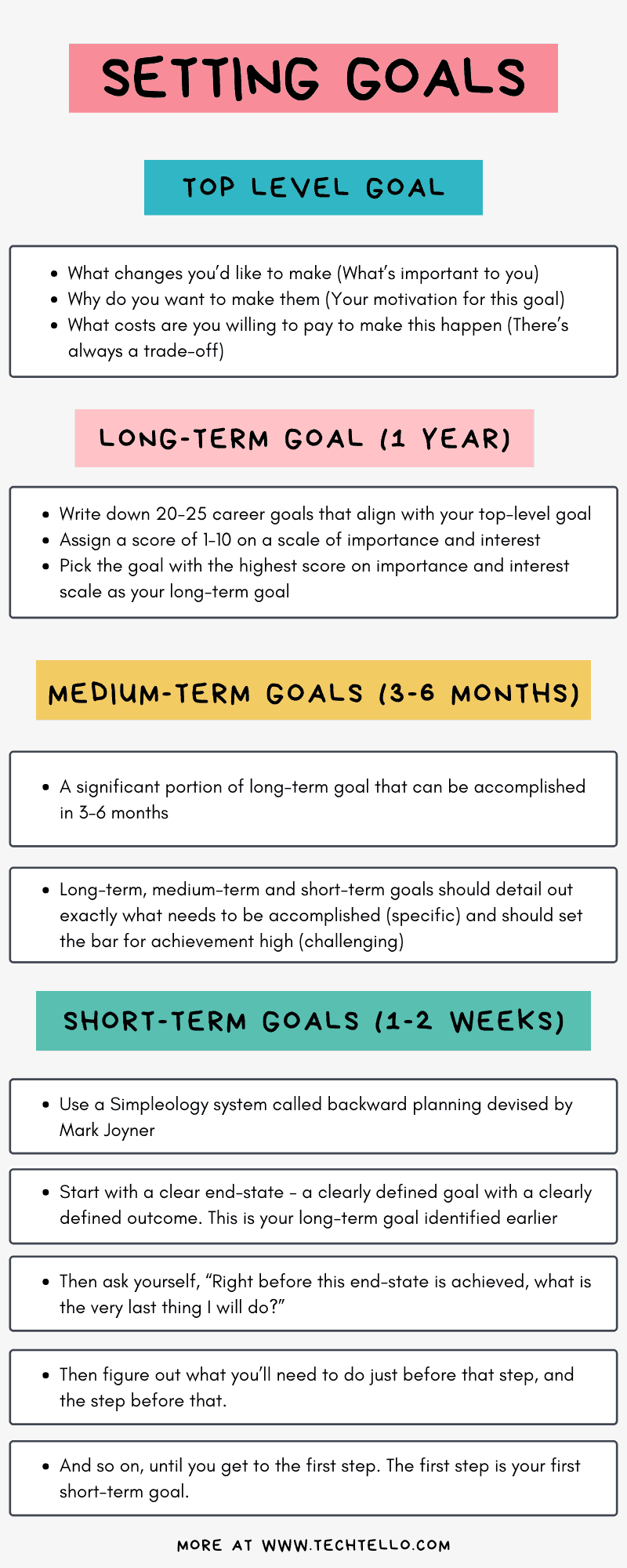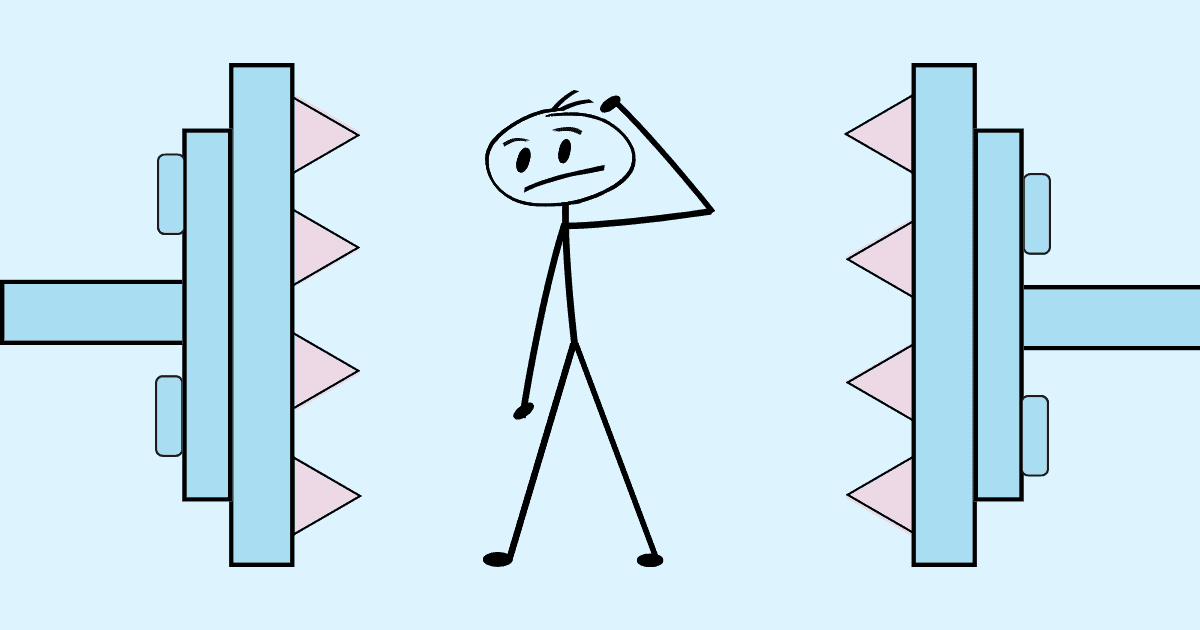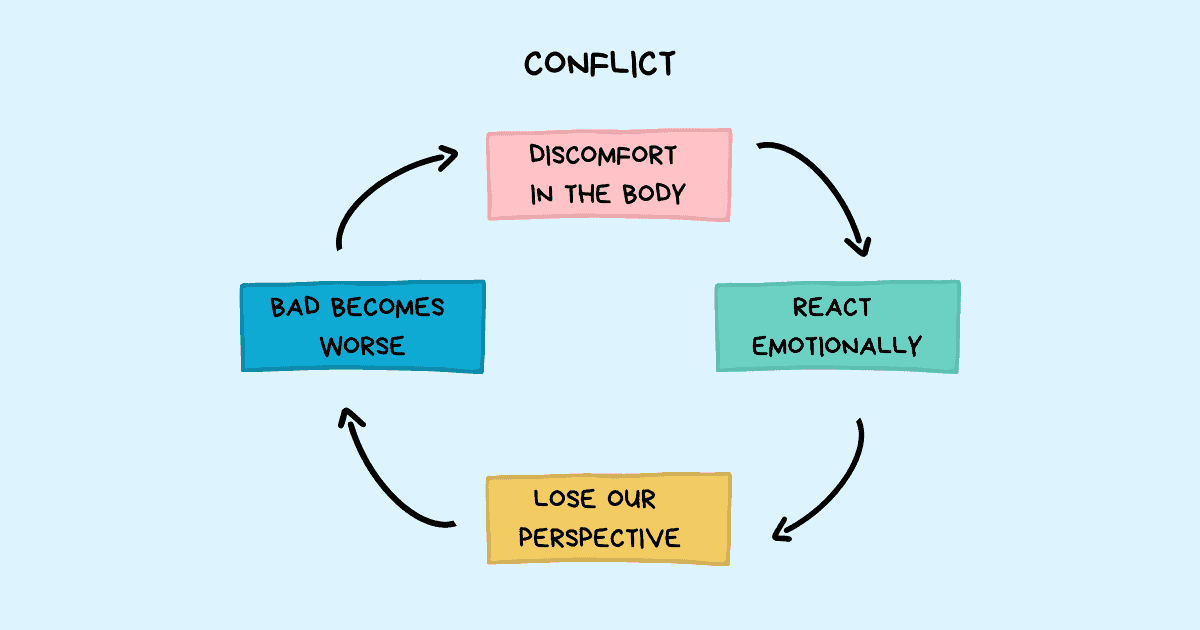Goal Setting: Get a Clear Fix on Where You Want to Go

Everyone likes to achieve success at work, but very few take the time to define what “success” means to them. Does it involve an increase in salary or acquiring a new skill? Is it receiving rewards and recognition for your work or getting an opportunity to work on the big bet? Do you feel successful when mentoring others or when you are able to solve a tough problem on your own?
To be successful, you need to define it first – something that drives all your actions. Something that gives you guidelines and boundaries to keep you on track. Something that helps you plan your progress. Something that gives you direction when you feel lost. And what is that something? A top-level goal. A consciously adopted goal is not only important, it’s the only way to act with intention instead of reacting to whatever life throws your way.
Most of us have many desires at work. We fantasize about a positive future. But we are always too busy or too lazy to turn them into goals. Without defining what it is that we want, we let many opportunities slip by. We fail to make the best use of every situation and let distractions eat away into our mental energy and time. Engaging in idle gossip at work instead of using the time to learn something new. Working on inconsequential tasks instead of proactively looking for projects which will help us build new skills. Scrolling through social media feed or wasting time in trying to get to inbox zero, when the same time can be used to explore a new idea.
Not defining goals has another pitfall – you fall for the thinking “I am doing my best!”
Do you know what’s your best?
How do you know it’s your best if you haven’t even defined what best looks like?
Trying to do your best in every situation is signing up for mediocrity. It’s an excuse to stay where you are instead of putting in the effort to where you can reach. If goal setting is so useful, why are we so reluctant to do it?
Because we are scared. We want output without the input. We want the rewards without facing the challenges and putting in the hard work that goes into generating that reward. We want it all and we want it easy. No doubt, we live in our dreams and fail to execute in our reality.
James Clear, author of Atomic Habits beautifully captures this idea in his blog “Goal setting is not only about choosing the rewards you want to enjoy, but also the costs you are willing to pay. The real challenge is not determining if you want the result, but if you are willing to accept the sacrifices required to achieve your goal. Do you want the lifestyle that comes with your quest? Do you want the boring and ugly process that comes before the exciting and glamorous outcome?”
Amazing Goal Planner
Become your best self by setting and achieving goals in all important areas of your life.
The dream car
What does your dream car look like? Really, think about it for a moment – which color is it, what’s its size, how many people can it seat, what features does it have, what’s special about that car?
While visualizing your dream car did you fit it into the specifications provided by your boss or you had your own version? Your boss can be useful to help you select your dream car and ensure you are making the right investment, but they cannot define that dream car for you. Your version is your own. It’s unique. It’s what matters to you. Goals are just like that dream car. They are your own. They are unique to you.
Imagine a year from now and answer these questions:
- How much money you want to earn?
- What skills would you like to have?
- What type of a role you want to play in your organization?
- What kind of problems do you want to solve?
- Who do you want to work with?
Would you feel right if your manager were to decide these for you? Absolutely not. Yet, most of us leave our goals to our managers. Letting them limit what we can achieve by operating within their constraints. We do the work that’s assigned to us instead of determining how we can get the problems we want to solve. We spend all our time delivering one project after another without making sure we create space for the things we want to learn. We use the skills that the project demands instead of looking for projects with the skills we want to build. We work with the people who are connected to a project instead of actively looking for people we want to work with.
Seriously, your manager cannot do their job and be also held responsible for your growth. They can help you with the right opportunities, coach you into building new skills, introduce you to the right people, assign you a mentor and give you the kind of problems you want to solve. But, to do all this right, you have to define your goals first. You have to manage up. You have to let them know what it is that you are after and then ask for their help in turning it into a reality.
A lot of learning and investment needs to happen from your side. Your own initiative will determine where you end up. As David Schwartz says in The Magic of Thinking Big “There is no limit to what you can learn once you see yourself as a scientist in your own lab. The important thing is not where you were or where you are but where you want to get. Get a clear fix on where you want to go.”
Now that you know goal setting is your responsibility. It’s not your manager’s job. Let’s get to the process of goal-setting.
Daily Weekly Monthly Planner Worksheets
Manage your to-do list, stay productive and cultivate healthy life habits with these planners.
Steps to goal setting

Instead of letting your day be an adhoc execution of tasks, you can carefully and purposefully organize your work to be a part of one supreme goal – your top level goal that directs your behaviour and guides all your actions. This top-level goal sits at the top of your goal hierarchy. In Grit, Angela Duckworth describes it as “When you have to divide your actions among a number of very different high-level career goals, you’re extremely conflicted. You need one internal compass—not two, three, four, or five.” This internal compass is your top-level goal.
Next in the hierarchy comes your long-term goal. Unlike most people who suggest looking three and five years down the line, I suggest thinking of your long-term goal as something you want to achieve in a year from now. This is your single most important point of focus for the entire year.
Next in the hierarchy is multiple medium term-goals which typically take 3-6 months to complete. All medium-term goals that you set for yourself roll into your long-term goal. Finally, comes your short-term goals at the lowest level in the hierarchy. Short-term goals take between 1-2 weeks to complete and are aligned with your medium-term goals.
To set goals for yourself:
- Choose a sub-goal of your top-level goal that you want to accomplish in the next one year. This is your long-term goal (1 year goal).
- Select a medium term goal that you can accomplish in the next 3-6 months. It’s ideally a big part of your long-term goal.
- Find a short-term goal that you can accomplish in 1-2 weeks.
- Now get down to work and focus on completing this short-term goal. Once completed, choose the next short-term goal to get to your medium-term goal.
- Once a medium-term goal is accomplished, choose a new medium-term goal to get to your long-term goal (1 year goal).
- Once your long-term goal is completed, choose another long-term goal and repeat these steps.
Here’s a goal-setting example:
| Top-Level Goal | Stay healthy |
| Long-Term Goal (1 year) | Run thrice per week for thirty minutes |
| 1st Medium-Term Goal (3 months) | Run twice per week for fifteen minutes |
| 1st Short-Term Goal (2 weeks) | Jog for five minutes [Monday and Wednesday at 6:30 A.M outside my apartment] |
| 2nd Short-Term Goal (2 weeks) | Run for five minutes [Monday and Wednesday at 6:30 A.M outside my apartment] |
| 3rd Short-Term Goal (2 weeks) | Jog for five minutes and then run for five minutes [Monday and Wednesday at 6:30 A.M outside my apartment] |
| 4th Short-term Goal (2 weeks) | Run for ten minutes [Monday and Wednesday at 6:30 A.M outside my apartment] |
| 5th Short-Term Goal (2 weeks) | Jog for five minutes and then run for ten minutes [Monday and Wednesday at 6:30 A.M outside my apartment] |
| 6th Short-Term Goal (2 weeks) | Run for fifteen minutes [Monday and Wednesday at 6:30 A.M outside my apartment] |
Here’s another goal-setting example:
Long-term goal (1 year): Improve platform metrics by 20%
Medium-term goal (3-6 months): Improve platform metrics by 10%
Short-term goal (1-2 weeks): Improve the response time of the product from [A] to [B]
Short-term goal (1-2 weeks): Reduce the failure rate of the external API calls from [C] to [D]
Michelangelo Buonarroti, a Renaissance artist once said “The greater danger for most of us is not that our aim is too high and we miss it, but that it is too low and we hit it.” In a study, Edwin Locke and Gary Latham, two eminent organizational psychologists found that goals that detail out exactly what needs to be accomplished (specific), and that set the bar for achievement high (challenging) result in far superior performance than goals that are vague or that set the bar too low.
When setting these goals, don’t aim too low. Don’t aim to do your best. Don’t settle for too little with a fear of failure. Don’t let your fixed mindset set the limits on what you can accomplish or as Carol Dweck says in Mindset “The view you adopt for yourself profoundly affects the way you lead your life. It can determine whether you become the person you want to be and whether you accomplish the things you value.” Set specific and challenging goals. Don’t aim low.
Wheel of Life Assessment
Use this wheel of life worksheet to enhance your overall well-being by identifying and aligning different areas of your life.
How to choose right goals
As you followed the steps in the process described above, did you struggle with adopting the right goals for yourself? It’s not uncommon. Most of us find it hard to settle in on one long-term goal for an entire year when so many other goals compete for our attention or to break down a long-term goal into a series of medium and short-term goals that fit together. But, not anymore.
I will help you with the process to identify all your goals in the goal hierarchy.
How to identify a top level goal
Your top-level goal is your lens that guides all your thoughts, words and actions at work. Something that gives you guidelines and boundaries to keep you on track. It acts as a compass and gives direction and meaning to all the goals below it. It helps you stay connected even during your most difficult times and setbacks.
To identify your top-level work goal, ask yourself these questions:
- What changes you’d like to make (What’s important to you)?
- Why do you want to make them (Your motivation for this goal)?
- What costs are you willing to pay to make this happen (There’s always a trade-off)?
Top-level goal setting will require a little bit of contemplation and a lot of patience. You may not get your answer on day one, but if you keep working on these questions, the right answer will present itself some day.
How to choose a long term goal
- Write down 10-15 long-term goals that align with your top-level goal. It’s fine if you can’t think of 10-15 goals. Write down as many as you can. Idea is to think deeply about every action that can contribute to your top-level goal.
- Revisit the list created above and look for patterns and common themes amongst these goals. Identify the goals that can be combined together into one main goal.
- To each of these goals, assign a score of 1-10 on a scale of importance with 1 being the least important and 10 being the most important, then again a score of 1-10 on a scale of interest with 1 being the least interesting and 10 being the most interesting.
- Pick the goal with the highest score on the importance and interest scale as your first long-term goal. It’s quite unlikely that multiple goals will have the same importance and interest score. If they do, in all likelihood they are part of the same goal. Rethink how they can be combined into one long-term goal.
- Work with your manager to set this as your goal for the next one year.
How to identify short term goals
To identify and connect short-term goals that fit into your long-term goal, use a Simpleology system called backward planning devised by Mark Joyner. Here’s how it works:
- Start with a clear end-state – a clearly defined goal with a clearly defined outcome. This is your long-term goal identified in the previous step. You should be able to visualize what it looks like when you have achieved the outcome. For example, let’s say your long-term goal (1 year) is publishing an online course. Visualize what achieving this state would look like.
- Then ask yourself, “Right before this end-state is achieved, what is the very last thing I will do?” In the example above, the very last step you will do is press the publish button and make the course available to everyone.
- Then figure out what you’ll need to do just before that step. In the example above, you will review your course to make sure all assets are in place before pressing the publish button.
- Then think about the step before that, and so on, until you get to the first step. This first step is your first short-term goal. In this example, the first step might be to brainstorm ideas for your online course. As you follow this exercise, you will get all the steps linked to achieving your goal.
Using this process, you can identify your short-term goals and combine them into multiple medium-term goals that fit together to form your long-term goal.
Your goals aren’t written in stone and you need to adjust them according to your situation as you make progress along the way. Goals are only the first step. You need sustainable and repeatable systems that give life to your goals. Systems that stick, that work, that give you useful feedback so that you are not blind to your own progress. Just like goals, you are also responsible for your own systems. If something is not working, you probably need to look at your systems and make necessary corrections.
It’s easy to blame others for what you are not able to achieve. It’s hard to accept that you are 100% responsible for your own situation. Decide what you want at work, take complete responsibility, experiment, seek help, ask for feedback and make adjustments along the way. Small continuous improvements will add up to major life goals or as Tom Hiddleston said “You never know what’s around the corner. It could be everything. Or it could be nothing. You keep putting one foot in front of the other, and then one day you look back and you’ve climbed a mountain.”
Summary
Goal setting turns your dreams into reality:
- Identify your top-level goal. It’s what gives direction to your work.
- Set your long-term goal for one year. It’s the work with the highest level of importance and that generates your maximum interest.
- Identify your medium (3-6 months) and short-term goals (1-2 weeks) that serve to fulfill your long-term goals.
- Keep your long-term goal and all goals underneath it specific and challenging.
- Take 100% responsibility for your goals. If you face challenges and setbacks, look to correct your systems instead of blaming others for your failures.
- Make adjustments to your goals based on feedback and new learnings.
- Work with your manager to fulfill these goals.






























